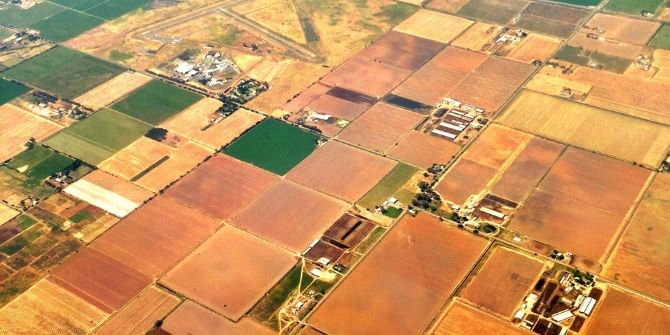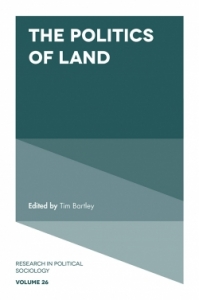In The Politics of Land, editor Tim Bartley brings together contributors to highlight the significance of the neglected issue of land to political sociology. This is a highly informative volume that explores a range of issues related to the land-politics nexus beyond the top-down understanding of its role in capitalist accumulation with much potential for future sociological research, writes Alexander Dobeson.
The Politics of Land. Tim Bartley (ed.). Emerald. 2019.
This important volume, edited by Tim Bartley, highlights the significance of the neglected issue of land – an empirical field usually ‘outsourced’ to rural sociology departments at agricultural universities and the bread-and-butter subject of human geographers – to political sociology. Evidence that the study of land does not merely represent a new niche, but is a central topic of mainstream sociology is provided by the sheer breadth of issues related to the land–politics nexus discussed in this volume, ranging from the role of the state and fiscal sociology through social movements to regulation and inequality. It is moreover refreshing to see both senior and early-career scholars and a diverse range of mixed methods, including historical, statistical and qualitative analysis, in the contributions. This underscores the resurgent interest in land and related issues, even though Barrington Moore (1966) and Jeffrey M. Paige (1975) put it at the centre of their seminal accounts decades ago.
Drawing on Karl Polanyi’s (2001) conceptualisation of land as a ‘fictitious commodity’ – a quasi-commodity that was not produced for the market in the first place – Bartley’s introduction sets out that the commodification of land is always a highly contested political process. Against this backdrop and supported by the empirical contributions to this volume, Bartley (4–5) therefore cautiously highlights that the appropriation of land and its transformation into commodity form is not merely a linear top-down process driven by powerful interest groups, as neo-Marxian scholars suggest (David Harvey, 1982), but is contingent on its embeddedness in existing institutional frameworks, the role of the state, local relations and societal ‘countermovements’ to its commodification (see also Bartley, 2018).
The volume’s first part, ‘Capacities’, revolves around the role of state and non-state actors in establishing control over land. In this light, the chapter by Simeon J. Newman sets out to challenge the neo-Weberian categorisation of the modern state as monopoliser of power by demonstrating how more or less strong efforts by the state to control squatter settlements in twentieth-century Lima, Peru, were undermined by neighbourhood elites seizing control over ‘their’ turf for the purpose of opportunistic rent-seeking. The limits of state power in the face of landed interests are furthermore supported by Isaac William Martin’s Polanyian account of land, which shows that property tax limitations hedge land owners from the volatility of market valuation in some US states, building the bedrock of a conservative countermovement that, ironically, leads to the exposure of weaker, landless groups to market forces. The question of why and how more progressive land reform movements were more successful with institutionalising land taxes in some states (and countries) than in others, however, remains an intriguing puzzle for future research.

Credit: Claire Armstrong (CC BY SA 2.0)
Delving deeper into the dynamics of countermovements, the second part deals with ‘Coalitions’ of activists and their often disruptive careers in land politics. Drawing on ethnographic observations and interviews with people involved in the anti-fracking movement in Illinois, Amanda Buday’s account shows how the increasing professionalisation of a social movement leads to polarisation between grassroots activists and professionals, giving way to the organisation of a ‘conservative’ (in its current US sense) pro-fracking countermovement campaigning against the regulation of land for shale gas extraction. Buday seems largely concerned with the dynamics and conflicts of social movements in the course of their professionalisation rather than problematising their dynamics as a consequence of the peculiarity of land itself. Henning Deters’s chapter on the soil protection gap in the European Union, however, argues that land, because of its physical nature, is prone to being reframed as a local issue by powerful interest groups, thus hampering successful coalition-building around land-related matters in a complex supranational policy setting.
The fact that the politics of land is not merely driven by political actors, but shaped within broader relational arrangements, is made clear in the volume’s third part, ‘Classifications’, which underscores the contingent embeddedness of land and its transformative character over time. In this light, David Balgley’s chapter on land access in Morocco’s Gharb Region maps out how centuries-old systems of land management were transformed within a complex assemblage of (colonial) officials, rights holders and governing devices, including cadastral maps and title deeds that make land ‘legible’ (James S. Scott) as a quantifiable stock of legitimate private property, while at the same time building the bedrock of neoliberal restructuring in the region. With a more urban focus on ‘green gentrification’ in the US, Joshua Sbicca’s chapter demonstrates how the revalorisation of landed property is driven by the difference between its use and its exchange value. Accordingly, the devaluation of land in Denver after the foreclosure crisis attracted grassroots initiatives that were subsequently appropriated by a ‘green growth machine’ in which local policymakers and developers strategically incorporated ideas about urban farming to spur green gentrification, leading to the displacement of the pioneers of urban agriculture and other income-weak segments of the population over time.
The volume’s final part, ‘Expulsions’, draws together three different empirical case studies that look at the local, institutional and national dynamics in which conflicts around land distribution take place. Unlike Marxian conceptions, in which the appropriation of land is driven by accumulation under the state, the case studies ask how and under what conditions social movements can mobilise against perceived land grabs and state authority by building coalitions that challenge the ownership and distribution of land. Marie Gagné’s study of resistance against land grabs in Senegal shows that a movement’s success largely depends on its degree of mobilisation and cohesion. Hence, ‘scaling-up’ through training and support from national and international NGOs, the capacity to win the support of local elites and decision-makers and, finally, the legal status of the land in question make land rights allocated by rural councils more easily revocable. Conversely, state- or privately-owned land is prone to encourage parties to pursue legal action, backed up by formalised property rights.
In a similar vein, In Hyee Hwang asks why some demands from expropriated farmers for compensation have been more successful than others in rural China. Drawing on field interviews and survey data, the author shows that compensation has been granted selectively to those who approach higher local officials, who, in turn, in an effort to safeguard their party careers, try to maintain political stability in the region by granting generous welfare provisions to expropriated farmers. While Hwang’s contribution provides insights into how authoritarian states maintain stability and tame public unrest, while at the same time fostering economic growth through the development of land, the case study presented by Gabriel Nelson illustrates (yet again) that the capacity of the state may vary from region to region. As Colombia’s long history of violent conflicts and displacement of rural populations show, regions with weak state capacity may result in reversals of land reform and growing concentration of ownership.
While Bartley admits that none of the chapters make a point of arguing what is unique about land (6), it is nevertheless striking that most of the case studies deal rather implicitly with the land question, with few exceptions putting landed property at the centre of their analysis (Martin, Deters, Sbicca). This can nevertheless be seen as a strength rather than a weakness partly because of Bartley’s excellent introduction, in which he pinpoints some ‘baseline answers’ that give insights into the awkward standing of land in the realm of commodities, derived from the case studies (6–11). Accordingly, the politics of land is typically bound by its (i) fixity (although territorial boundaries may be exceeded by cross-border externalities such as environmental pollution); (ii) its tendency to provoke both reactionary and progressive social movements and coalitions; (iii) its central importance to territorial control (the state and control are not synonymous); and (iv) price swings characterised by a temporal difference between rapidly changing exchange value and relatively inert use values. While this list is far from a definitive and exhaustive phenomenology of land, it provides an empirically grounded overview open for debate to future scholars and students dedicated to the sociological study of land. A more comprehensive understanding of land and its peculiar standing in the commodity domain will also require the involvement of approaches from adjacent fields to political sociology, in particular economic sociology and the sociology of markets, which to date have shied away from dealing more systematically with the economy of land and the social organisation of its markets.
All in all, this is a highly informative volume in which each contribution highlights different aspects of the politics of land beyond the rather one-dimensional top-down understanding of its role in capitalist accumulation. In this light, it is the contribution of Bartley and his authors to have initiated a broader debate with much potential for future sociological research. It goes without saying that more in-depth case studies are needed, in particular cross-country comparisons, in order to deepen our knowledge of how the mother of all commodities has been institutionalised and constrained as the backbone of the modern market economy.
Please read our comments policy before commenting.
Note: This article is provided by our sister site, LSE Review of Books. It gives the views of the author, not the position of EUROPP – European Politics and Policy or the London School of Economics.
_________________________________
Alexander Dobeson – Uppsala University / LSE
Alexander Dobeson is a researcher at the Department of Sociology at Uppsala University and currently a visiting fellow at LSE Sociology. His current research project investigates the socio-technical, institutional and cultural practices of land valuation.


 Find this book:
Find this book: 
